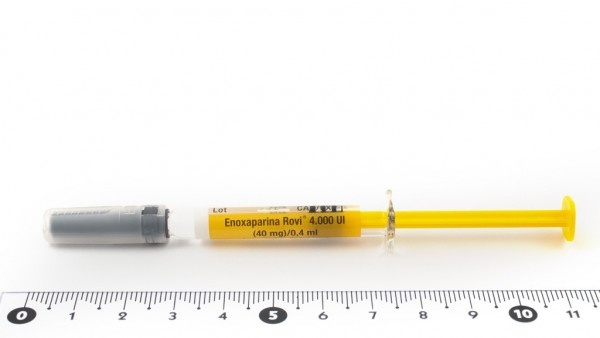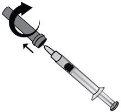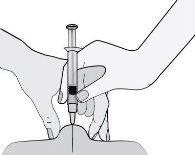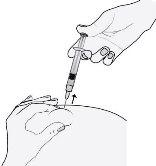

ENOXAPARIN LEDRAXEN 4,000 IU (40 mg)/0.4 mL PRE-FILLED SYRINGE SOLUTION FOR INJECTION

Ask a doctor about a prescription for ENOXAPARIN LEDRAXEN 4,000 IU (40 mg)/0.4 mL PRE-FILLED SYRINGE SOLUTION FOR INJECTION

How to use ENOXAPARIN LEDRAXEN 4,000 IU (40 mg)/0.4 mL PRE-FILLED SYRINGE SOLUTION FOR INJECTION
Introduction
Package Leaflet: Information for the User
Enoxaparina Ledraxen 4,000 IU (40 mg)/0.4 ml Solution for Injection in Pre-filled Syringe
enoxaparina sodium
This medicine is subject to additional monitoring, which will allow for quick identification of new safety information. You can help by reporting any side effects you may get. The last section of the leaflet contains information on how to report side effects.
Read all of this leaflet carefully before you start using this medicine, because it contains important information for you.
- Keep this leaflet, you may need to read it again.
- If you have any further questions, ask your doctor, pharmacist, or nurse.
- This medicine has been prescribed for you only. Do not pass it on to others. It may harm them, even if their signs of illness are the same as yours.
- If you get any side effects, talk to your doctor, pharmacist, or nurse. This includes any possible side effects not listed in this leaflet. See section 4.
Contents of the Package Leaflet
- What is Enoxaparina Ledraxen and what is it used for
- What you need to know before you use Enoxaparina Ledraxen
- How to use Enoxaparina Ledraxen
- Possible side effects
- Storage of Enoxaparina Ledraxen
- Contents of the pack and other information
1. What is Enoxaparina Ledraxen and what is it used for
Enoxaparina Ledraxen contains the active substance enoxaparin sodium, which is a low molecular weight heparin (LMWH).
Enoxaparina Ledraxen works in two ways.
- Preventing existing blood clots from getting bigger. This helps your body to break them down and stop them from causing harm.
- Preventing new blood clots from forming in your blood.
Enoxaparina Ledraxen can be used to:
- treat blood clots
- prevent blood clots from forming in the following situations:
- before and after surgery
- when you have a short-term illness and are unable to move for a period of time
- if you have had a blood clot due to cancer, to prevent more clots from forming.
- to prevent blood clots when you have unstable angina (a condition where not enough blood reaches your heart) or after a heart attack.
- to prevent blood clots in the tubes of a dialysis machine (used in people with severe kidney problems).
2. What you need to know before you use Enoxaparina Ledraxen
N
- are allergic to:
- enoxaparin sodium or any of the other ingredients of this medicine (listed in section 6)
- heparin or other low molecular weight heparins such as nadroparin, tinzaparin, or dalteparin.
Signs of an allergic reaction include: rash, problems breathing or swallowing, swelling of the face, lips, tongue, mouth, throat, or eyes.
- have had a reaction to heparin that caused a severe decrease in the number of cells that help your blood to clot (platelets) in the last 100 days
- have antibodies against enoxaparin in your blood
- are bleeding heavily or have a high risk of bleeding, such as:
- stomach ulcer, recent brain or eye surgery, or brain bleeding.
- are using Enoxaparina Ledraxen to treat blood clots, and you are going to have:
- a spinal or epidural puncture
- surgery with spinal or epidural anesthesia.
A
Enoxaparina Ledraxen should not be exchanged with other medicines that belong to the group of low molecular weight heparins. This is because they are not exactly the same and do not have the same activity or instructions for use.
Talk to your doctor or pharmacist before you start using Enoxaparina Ledraxen if:
- you have ever had a reaction to heparin that caused a severe decrease in the number of cells that help your blood to clot (platelets)
- you have had a heart valve implanted
- you have endocarditis (an infection of the inner lining of the heart)
- you have a history of stomach ulcer
- you have recently had a stroke (brain attack)
- you have high blood pressure
- you have diabetes or problems with the blood vessels in your eyes caused by diabetes (called diabetic retinopathy)
retinopathy
- you have recently had eye or brain surgery
- you are an elderly person (over 65 years old) and especially if you are over 75 years old
- you have kidney problems
- you have liver problems
- you have a very low or very high body weight
- you have high levels of potassium in your blood (which could be checked with a blood test)
- you are currently using medicines that affect bleeding (see below - Using Enoxaparina Ledraxen with other medicines)
- you have any problems with your spine or have had spinal surgery.
If you are affected by any of these conditions (or are unsure), talk to your doctor or pharmacist before using Enoxaparina Ledraxen.
This medicine contains less than 1 mmol (23 mg) of sodium per dose, which is essentially "sodium-free".
Tests and Checks
You may need to have a blood test before you start using this medicine, and while you are using it; this is to check the level of cells that help your blood to clot (platelets) and the level of potassium in your blood.
Children and Adolescents
The efficacy and safety of Enoxaparina Ledraxen in children and adolescents have not been established.
Other Medicines and Enoxaparina Ledraxen
Tell your doctor or pharmacist if you are using, have recently used, or might use any other medicines.
- Warfarin - used to prevent blood clotting
- Aspirin (also known as acetylsalicylic acid or AAS), clopidogrel, or other medicines used to prevent blood clots (see also section 3, "Change of anticoagulant treatment")
- Dextran injection - used as a blood substitute
- Ibuprofen, diclofenac, ketorolac, and other medicines known as non-steroidal anti-inflammatory drugs (NSAIDs) used to treat pain and inflammation in arthritis and other diseases
- Prednisolone, dexamethasone, and other medicines used to treat asthma, rheumatoid arthritis, and other diseases
- Medicines that increase the level of potassium in your blood, such as potassium salts, diuretics, and some medicines used to treat heart problems
O
In case you are going to have a spinal or epidural puncture or are going to undergo surgery where spinal or epidural anesthesia will be used, inform your doctor that you are using Enoxaparina Ledraxen.
E
If you are pregnant, think you may be pregnant, or are planning to have a baby, consult your doctor or pharmacist before using this medicine.
If you are pregnant and have a mechanical heart valve, you may have a higher risk of blood clots. Your doctor will discuss this with you.
If you are breast-feeding or plan to breast-feed, you should consult your doctor before using this medicine.
C
Enoxaparina Ledraxen does not affect the ability to drive and use machines.
It is recommended that the healthcare professional record the trade name and batch number of the product you are using.
3. How to use Enoxaparina Ledraxen
Follow the instructions for administration of this medicine exactly as told by your doctor or pharmacist. If you are unsure, consult your doctor or pharmacist again.
U
- Normally, your doctor or nurse will give you Enoxaparina Ledraxen. This is because it needs to be given by injection.
- Enoxaparina Ledraxen is usually given by injection under the skin (subcutaneously).
- Enoxaparina Ledraxen can be given by injection into your veins (intravenously) after certain types of heart attacks and surgery.
- Enoxaparina Ledraxen can be added to the tube that comes out of your body (arterial line) at the start of a dialysis session.
- Do not give Enoxaparina Ledraxen by injection into a muscle (intramuscularly).
Q
- Your doctor will decide the amount of Enoxaparina Ledraxen that you will be given. The amount will depend on the reason why you are using it.
- If you have kidney problems, you may be given a smaller amount of Enoxaparina Ledraxen.
- Treatment of blood clots:
- The usual dose is 150 IU (1.5 mg) per kilogram of body weight every day or 100 IU (1 mg) per kilogram of body weight twice a day.
- Your doctor will decide how long you will receive Enoxaparina Ledraxen.
- Prevention of blood clots during surgery or periods of limited mobility due to illness:
- The dose will depend on your risk of developing a blood clot. You will be given 2,000 IU (20 mg) or 4,000 IU (40 mg) of Enoxaparina Ledraxen per day.
If you are going to have surgery, you will usually be given the first injection 2 or 12 hours before the surgery.
- If you have limited mobility due to illness, you will usually be given 4,000 IU (40 mg) of Enoxaparina Ledraxen per day.
Your doctor will decide how long you will receive Enoxaparina Ledraxen.
- Prevention of blood clots in the tubes of a dialysis machine
- The usual dose is 100 IU (1 mg) per kilogram of body weight.
- Enoxaparina Ledraxen is added to the tube that comes out of your body (arterial line) at the start of the dialysis session. This amount is usually enough for a 4-hour session. However, your doctor may give you another injection of 50 IU to 100 IU/kg (0.5 to 1 mg/kg) per kilogram of body weight if needed.
If you are going to inject Enoxaparina Ledraxen yourself
If you can give yourself Enoxaparina Ledraxen, your doctor or nurse will show you how to do it. Do not try to inject yourself if you have not been taught how to do it. If you are unsure what to do, consult your doctor or nurse immediately.
Before you inject Enoxaparina Ledraxen yourself
- Prepare what you need: syringe, cotton ball with alcohol or soap and water, and a container for sharp objects
- Check the expiry date of the medicine. If it has expired, do not use it
- Check that the syringe is not damaged and that the medicine solution is clear. If it is not, use another syringe
- Make sure you know the amount to be injected
- Check the area of your stomach where you will inject to see if the last injection caused redness, change in skin color, swelling, discharge, or pain that still persists. If this happens, consult your doctor or nurse
I
To reduce pain and bruising at the injection site, it is necessary to use the syringes properly. Follow the instructions carefully.
Instructions for syringe without safety system
- Preparation of the injection site:
Before injecting, wash and dry your hands. With a cotton ball, clean (without rubbing) the area you have chosen for the injection.
Choose a different area of your stomach for each injection.
- Remove the cap that protects the needle.
You may see a drop at the end of the needle. If this happens, remove the drop by gently tapping the syringe body (with the needle pointing down).

- Performing the injection:
The pre-filled syringe is ready for immediate use. Choose an area on the right or left side of your stomach. It should be at least 5 cm away from your navel and towards the sides. Hold the syringe so that the needle points downwards (vertically at a 90-degree angle), within the thickness of a skin fold that you are pinching with your thumb and index finger. The skin fold should be kept pinched throughout the injection.
|
|
- Dispose of the syringe immediately in the appropriate container.
The disposal of unused medicine and all materials that have come into contact with it will be carried out in accordance with local regulations.
Instructions for syringe with safety system
- Preparation of the injection site:
Before injecting, wash and dry your hands. With a cotton ball, clean (without rubbing) the area you have chosen for the injection.
Choose a different area of your stomach for each injection.
- First, tilt the trap to one side by about 90 degrees. Important: Do not remove the cap before tilting the trap!

- Remove the cap that protects the needle.
You may see a drop at the end of the needle. If this happens, remove the drop by gently tapping the syringe body (with the needle pointing down).

- Performing the injection:
The pre-filled syringe is ready for immediate use. Choose an area on the right or left side of your stomach. It should be at least 5 cm away from your navel and towards the sides. Hold the syringe so that the needle points downwards (vertically at a 90-degree angle), within the thickness of a skin fold that you are pinching with your thumb and index finger. The skin fold should be kept pinched throughout the injection.

- Secure the needle:
Fix the needle by placing the trap against a hard and stable surface using one hand. Then press the trap down. Important: Do not use your finger to fix the needle to the trap! Tilt the trap until the needle is introduced into the plastic piece, emitting a click.


When you have finished
- To avoid bruising, do not rub the injection site after the injection.
- Put the used syringe in the container for sharp objects. Close the container lid tightly and keep it out of the reach of children. When the container is full, dispose of it as your doctor or pharmacist has told you.
The disposal of unused medicine and all materials that have come into contact with it will be carried out in accordance with local regulations.
C
- Switching from Enoxaparina Ledraxen to medications that reduce blood coagulation called vitamin K antagonists (e.g., warfarin)
Your doctor will request a blood test to determine a parameter called INR and will tell you when to stop treatment with Enoxaparina Ledraxen.
- Switching from medications that reduce blood coagulation called vitamin K antagonists (e.g., warfarin) to Enoxaparina Ledraxen
Stop using the vitamin K antagonist. Your doctor will request a blood test to determine a parameter called INR and will tell you when to start using Enoxaparina Ledraxen.
- Switching from Enoxaparina Ledraxen to treatment with direct oral anticoagulants
Stop using Enoxaparina Ledraxen. Start taking the direct oral anticoagulant 0-2 hours before the next scheduled injection, and then continue as usual.
- Switching from treatment with direct oral anticoagulant to Enoxaparina Ledraxen
Stop taking the direct oral anticoagulant. Do not start treatment with Enoxaparina Ledraxen until 12 hours have passed since the last dose of the direct oral anticoagulant.
If you use more Enoxaparina Ledraxen than you should
If you think you have used too much or too little Enoxaparina Ledraxen, inform your doctor, nurse, or pharmacist immediately, even if you do not have any signs of problems. If a child accidentally injects or swallows Enoxaparina Ledraxen, take them to the emergency department of a hospital immediately.
S
If you forget to administer a dose, do so as soon as you remember. Do not use a double dose on the same day to make up for missed doses. To ensure you do not miss any doses, using a diary may be helpful.
S
It is essential that you continue to receive Enoxaparina Ledraxen until your doctor decides to stop treatment. If you stop using it, a blood clot may form, which can be very dangerous.
If you have any further questions about the use of this medication, ask your doctor, pharmacist, or nurse.
4. Possible side effects
Like all medications, this medication can cause side effects, although not everyone will experience them.
Severe side effects
Stop treatment with Enoxaparina Ledraxen and inform your doctor or nurse immediately if you experience any signs of a severe allergic reaction (such as a rash, breathing or swallowing problems, swelling of the face, lips, tongue, mouth, throat, or eyes).
Stop treatment with Enoxaparina Ledraxen and inform your doctor or nurse immediately if you experience any of the following symptoms:
- a widespread, red, and scaly rash, with bumps under the skin and blisters, accompanied by fever. Symptoms usually appear at the start of treatment (acute generalized exanthematous pustulosis).
Like other similar medications for reducing blood clots, Enoxaparina Ledraxen may cause bleeding. This could be life-threatening. In some cases, the bleeding may not be apparent.
Inform your doctor immediately if:
- you have any bleeding that does not stop by itself
- you have signs of excessive bleeding (such as feeling very weak, tired, pale, or dizzy with a headache or unexplained swelling).
Your doctor may decide to keep you under close observation or change your medication.
You must inform your doctor immediately:
- if you experience any signs of a blood vessel blockage due to a blood clot, such as:
- cramping pain, redness, warmth, or swelling in one of your legs – which are symptoms of deep vein thrombosis
- difficulty breathing, chest pain, fainting, or coughing up blood – which are symptoms of pulmonary embolism
- if you have a painful skin rash with dark red spots under the skin that do not disappear when pressed.
Your doctor may request a blood test to check the platelet count.
O
Very common (may affect more than 1 in 10 people)
- Bleeding.
- Increased liver enzymes.
Common (may affect up to 1 in 10 people)
- If bruises appear more frequently than usual. This could be due to a blood problem caused by a low platelet count.
- Pink patches on the skin. These appear more frequently in the area where Enoxaparina Ledraxen was injected.
- Skin rash (hives, urticaria).
- Redness and itching of the skin.
- Bruising or pain at the injection site.
- Decreased red blood cell count in the blood.
- Increased platelet count in the blood.
- Headache.
Uncommon (may affect up to 1 in 100 people)
- Sudden severe headache. This could be a sign of bleeding in the brain.
- Feeling of tenderness and swelling of the stomach. This could be indicative of gastric bleeding.
- Large, irregular red lesions on the skin, with or without blisters.
- Skin irritation (local irritation).
- You may notice yellowing of the skin or eyes, and darkening of the urine color. This could be due to a liver problem.
Rare (may affect up to 1 in 1,000 people)
- Severe allergic reaction. The signs of this reaction may include: skin rash, difficulty swallowing or breathing, swelling of the lips, face, throat, or tongue.
- Increased potassium in the blood. This is more likely to occur in people with kidney problems or diabetes. Your doctor can check this with a blood test.
- Increased eosinophil count in the blood. Your doctor can check this with a blood test.
- Hair loss.
- Osteoporosis (a disease in which bones can fracture more easily)
after prolonged use.
- Numbness, tingling, and weakness in the muscles (especially in the lower body) when a lumbar puncture or spinal anesthesia has been performed.
- Loss of bladder or bowel control (so that you cannot control your needs).
- Hardening or nodule at the injection site.
C
If you experience any side effects, consult your doctor, pharmacist, or nurse, even if it is a possible side effect not listed in this leaflet. You can also report them directly through the Spanish Pharmacovigilance System for Human Use Medicines: www.notificaRAM.es. By reporting side effects, you can help provide more information on the safety of this medication.
5. Storage of Enoxaparina Ledraxen
Store below 25 °C.
Do not freeze.
Keep this medication out of sight and reach of children.
Do not use this medication after the expiration date stated on the packaging after CAD. The expiration date is the last day of the month indicated.
Do not use this medication if you notice any visible change in the appearance of the solution.
Medications should not be disposed of through wastewater or household waste. Deposit the packaging and any unused medications at the SIGRE collection point in your pharmacy. If in doubt, ask your pharmacist how to dispose of the packaging and any unused medications. This will help protect the environment.
6. Package contents and additional information
Composition of Enoxaparina Ledraxen
- The active ingredient is enoxaparin sodium.
Each 0.2 ml pre-filled syringe contains an anti-Xa activity of 2,000 IU (equivalent to 20 mg) of enoxaparin sodium
- The other components are water for injectable preparations.
Appearance of the product and package contents
The liquid is transparent, colorless, or light yellow.
0.2 ml of solution contained in a transparent, colorless, neutral, and type I glass syringe, with a fixed needle and a closed needle protector with a chlorobutyl rubber stopper and a black polypropylene plunger (without an automatic safety system).
Packaging of 1, 2, 6, 10, 20, or 50 pre-filled syringes.
For 0.2 ml and 0.4 ml syringes, the syringes are not graduated.
For 0.6 ml, 0.8 ml, and 1 ml syringes, the syringes are graduated.
Only some package sizes may be marketed.
Marketing authorization holder
Venipharm
4, Bureaux de la Colline
92210 Saint-Cloud
FRANCE
+33 1 47 71 16 98
Manufacturer
Centre Spécialités Pharmaceutiques (France)
ZAC des Suzots
35 rue de la Chapelle F-63450
Saint-Amant Tallende,
FRANCE
This medication is authorized in the Member States of the European Economic Area and in the United Kingdom (Northern Ireland) with the following names:
Germany Enoxaparin Ledraxen
United Kingdom Ledraxen
Sweden: Enoxaparin Ledraxen
Spain: Enoxaparina Ledraxen
France: Enoxaparine Arrow
Latvia: Enoxaparin sodium Ledraxen
Lettonia Enoxaparin sodium Ledraxen
Austria: Enoxaparin Ledraxen
Cyprus: Ledraxen
Czech Republic: Enoxaparin sodium Ledraxen
Estonia: Enoxaparin sodium Ledraxen
Finland: Enoxaparin Ledraxen
Croatia: Enoksaparinnatrij Ledraxen
Ireland: Enoxaparin sodium Ledraxen
Norway Enoxaparin Ledraxen
Poland: Enoxaparin sodium Ledraxen
Portugal: Enoxaparin Ledraxen
Slovakia: Ledraxen
Slovenia: Enoksaparin Ledraxen
Date of the last revision of this leaflet:June 2023
Other sources of information
Detailed information about this medication is available on the website of the Spanish Agency for Medicines and Health Products (AEMPS) (http://www.aemps.gob.es/)

How much does ENOXAPARIN LEDRAXEN 4,000 IU (40 mg)/0.4 mL PRE-FILLED SYRINGE SOLUTION FOR INJECTION cost in Spain ( 2025)?
The average price of ENOXAPARIN LEDRAXEN 4,000 IU (40 mg)/0.4 mL PRE-FILLED SYRINGE SOLUTION FOR INJECTION in November, 2025 is around 7.24 EUR. Prices may vary depending on the region, pharmacy, and whether a prescription is required. Always check with a local pharmacy or online source for the most accurate information.
- Country of registration
- Average pharmacy price7.24 EUR
- Availability in pharmaciesSupply issue reported
- Active substance
- Prescription requiredYes
- Manufacturer
- This information is for reference only and does not constitute medical advice. Always consult a licensed doctor before taking any medication. Oladoctor is not responsible for medical decisions based on this content.
- Alternatives to ENOXAPARIN LEDRAXEN 4,000 IU (40 mg)/0.4 mL PRE-FILLED SYRINGE SOLUTION FOR INJECTIONDosage form: INJECTABLE, 100 mg (10000 IU) enoxaparin sodium/mlActive substance: enoxaparinManufacturer: Sanofi Aventis S.A.Prescription requiredDosage form: INJECTABLE, 120 mg (12000 IU) /0.8 mlActive substance: enoxaparinManufacturer: Sanofi Aventis S.A.Prescription requiredDosage form: INJECTABLE, 150 mg (15000 IU) /1 mlActive substance: enoxaparinManufacturer: Sanofi Aventis S.A.Prescription required
Alternatives to ENOXAPARIN LEDRAXEN 4,000 IU (40 mg)/0.4 mL PRE-FILLED SYRINGE SOLUTION FOR INJECTION in other countries
The best alternatives with the same active ingredient and therapeutic effect.
Alternative to ENOXAPARIN LEDRAXEN 4,000 IU (40 mg)/0.4 mL PRE-FILLED SYRINGE SOLUTION FOR INJECTION in Poland
Alternative to ENOXAPARIN LEDRAXEN 4,000 IU (40 mg)/0.4 mL PRE-FILLED SYRINGE SOLUTION FOR INJECTION in Ukraine
Online doctors for ENOXAPARIN LEDRAXEN 4,000 IU (40 mg)/0.4 mL PRE-FILLED SYRINGE SOLUTION FOR INJECTION
Discuss dosage, side effects, interactions, contraindications, and prescription renewal for ENOXAPARIN LEDRAXEN 4,000 IU (40 mg)/0.4 mL PRE-FILLED SYRINGE SOLUTION FOR INJECTION – subject to medical assessment and local rules.
















